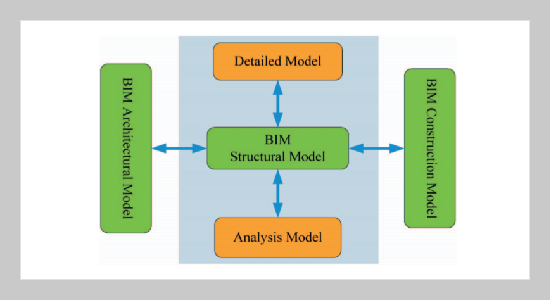REFERENCES
- [1] Barlish, K. and Sullivan, K., “How to Measure the Benefits of BIM: a Case Study Approach,” Automation in Construction, Vol. 24, pp. 149�159 (2012). doi: 10.1016/j.autcon.2012.02.008
- [2] Volk, R., Stengel, J. and Schultmann, F., “Building Information Modeling (BIM) for Existing Buildings: Literature Review and Future Needs,” Automation in Construction, Vol. 38, pp. 109�127 (2014). doi: 10. 1016/j.autcon.2013.10.023
- [3] Miettinen, R. and Paavola, S., “Beyond the BIM Utopia: Approaches to the Development and Implementation of Building Information Modeling,” Automation in Construction, Vol. 43, pp. 84�91 (2014). doi: 10. 1016/j.autcon.2014.03.009
- [4] Stowe, K., Zhang, S. J. and Teizer, J., “Capturing the Return on Investment of All-in Building Information Modeling: Structured Approach,” Practice Periodical on Structural Design and Construction, Vol. 20, No. 1, pp. 1�5(2015).doi:10.1061/(ASCE)SC.1943-5576.00 00221
- [5] Eadie, R., Odeyinka, H. and Browne, M., “An Analysis of the Drivers for Adopting Building Information Modeling,” Journal of Information Technology in Construction (ITcon), Vol. 18, pp. 338�352 (2013). Information on http://www.itcon.org/2013/17
- [6] Information on http://www.nationalbimstandard.org/, (Accessed 15.02.2014).
- [7] Dodge Report, “The Business Value of BIM for Construction in Major Global Markets,” Dodge Data & Analytics, pp. 30�35 (2014). Information on http://construction.com/
- [8] Fan, S. L., Skibniewski, M. J. and Hung, T. W., “Effects of Building Information Modeling During Construction,” Journal of Applied Science and Engineering, Vol. 17, No. 2, pp. 157�166 (2014). doi: 10.6180/ jase.2014.17.2.06
- [9] Diao, Y. T., Kato, S. and Hiyama,K., “Development of an Optimal Design Aid System Based on Building InformationModeling,” Building Simulation, Vol. 4, No. 4, pp. 315�320 (2011). doi: 10.1007/s12273-011-00 54-3
- [10] Zhang, S. J., Teizer, J. and Lee, J. K., “Building Information Modeling (BIM) and Safety: Automatic Safety Checking of Construction Models and Schedules,” Automation in Construction, Vol. 29, pp. 183�195 (2013). doi: 10.1016/j.autcon.2012.05.006
- [11] Cheng, J. C. P. and Das, M., “A BIM-based Web Service Framework for Green Building Energy Simulation and Code Checking,” Journal of Information Technology in Construction (ITcon), Vol. 19, pp. 150�168 (2014). Information on http://www.itcon.org/2014/8
- [12] Son, H. J., Lee, S. W. and Kim, C. W., “What Drives theAdoption ofBuildingInformationModelinginDesign Organizations? An Empirical Investigation of the Antecedents Affecting Architects’ Behavioral Intentions,”Automation inConstruction,Vol.49, pp. 92�99 (2015). doi: 10.1016/j.autcon.2014.10.012
- [13] Liu, Z. Q., Li, Y. G. and Zhang, H. Y., “An IFC-based Integration Tool for Supporting Information Exchange from Architectural Model to Structural Model,” Journal of Central South University of Technology, Vol. 17, No. 6, pp. 1344�1350 (2010). doi: 10.1007/s11771010-0640-z
- [14] Hamdi, O. and Leite, F., “Conflicting Side of Building Information Modeling Implementation in the Construction Industry,” Journal of Legal Affairs and Dispute Resolution in Engineering and Construction, Vol. 6, pp. 1�8 (2014). doi: 10.1061/(ASCE)LA.1943-4170. 0000137
- [15] Chi, H. L., Wang, X. Y. and Jiao, Y., “BIM-enabled Structural Design: Impacts and Future Development in Structural Modeling, Analysis and Optimization Processes,” Archives of Computational Methods in Engineering, Vol. 22, pp. 135-151 (2015). doi: 10.1007/s11 831-014-9127-7
- [16] Nawari, N. O. and Sgambelluri, M., “The role of National BIM Standard in Structural Design,” Structures Congress, Orlando, USA, pp. 1660�1671 (2010). doi: 10.1061/41130(369)151
- [17] Lee, S. I., Bae, J. S. and Cho, Y. S., “Efficiency Analysis of Set-based Design with Structural Building Information Modeling (S-BIM) on High-rise Building Structures,” Automation in Construction, Vol. 23, pp. 20�32 (2012). doi: 10.1016/j.autcon.2011.12.008
- [18] Qin, L., Deng, X. Y. and Liu, X. L., “Industry Foundation Classes Based Integration of Architectural Design and Structural Analysis,” Journal of Shanghai Jiaotong University (Science), Vol. 16, No. 1, pp. 83�90 (2011). doi: 10.1007/s12204-011-1099-2
- [19] Zhang, J. P. and Hu, Z. Z., “BIM-and 4D-based Integrated Solution of Analysis and Management for Conflicts and Structural Safety Problems during Construction: 1. Principles and Methodologies,” Automation in Construction, Vol. 20, pp. 155�166 (2011). doi: 10. 1016/j.autcon.2010.09.013
- [20] Lancaster, F. D. and Tobin, J., “Integrated Project Delivery: Next-generation BIM for Structural Engineering,” Structures Congress, Orlando, USA, pp. 2809� 2818 (2010). doi: 10.1061/41130(369)254
- [21] Robinson, C., “Structural BIM: Discussion, Case Studies and Latest Developments,” The Structural Design of Tall and Special Buildings, Vol. 16, pp. 519� 533 (2007). doi: 10.1002/tal.417
- [22] Xu, H. E., Feng, J. C. and Li, S. D., “Users-orientated Evaluation of Building Information Model in the Chinese Construction Industry,” Automation in Construction, Vol. 39, pp. 32�46 (2014). doi:10.1016/j. autcon.2013.12.004
- [23] Cao, D. P., Wang, G. B. and Li, H., “Practices and Effectiveness of Building Information Modeling in Construction Projects in China,” Automation in Construction, Vol. 49, pp. 113�122 (2015). doi: 10.1016/j.aut con.2014.10.014
- [24] Information on http://www.buildingsmart-tech.org/, (Accessed 27.08.2015). [25] Information on https://www.atcouncil.org/Projects/atc75-project.html/, (Accessed 22.08.2013)
















